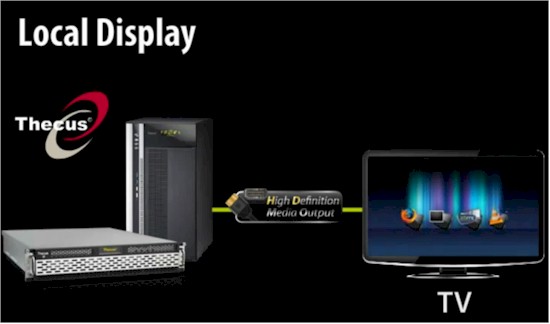Introduction
Many modern NASes have HDMI ports. But up until this point, they have provided only console access. Earlier this year, Thecus released its Local Display module. This add-in enables HDMI-equipped Thecus NASes, which include the N2800, N4800 and N5550, to output video to a connected display. The Local Display module is meant to open the door to using a Thecus NAS as an HTPC, possibly consolidating two machines into one.
The Local Display Module itself simply provides access to a (Linux) Firefox browser and a console terminal session. Third party (unsupported by Thecus) modules can also be installed to add more features to Local Display.
The goal of this article is to answer the question, “Can a Thecus NAS replace an HTPC?” Come along and see if you reach the same conclusion as I did.
Setup
I used a Thecus N5550 [reviewed] for this project. The N5550 is a relatively new NAS, positioned near the bottom of Thecus’ top-end Enterprise-Tower line. It is pretty powerful as current NASes go, with a dual-core Intel D2550 Atom CPU and 2 GB of DDR3 RAM. While it’s certainly not as powerful as an i3 or i5 PC, it’s not a Marvell-based low-end NAS either.
The Local Display video tutorial shows basic steps of plugging in an HDMI cable, USB mouse and keyboard and booting up into the Local Display module screen that includes an XBMC icon. But it’s not that easy. To get to the screen in the tutorial, you need first to ensure you are at firmware v2.03.02 or higher (I was on firmware 2.03.06.atom). Then you need to install the Local Display module from the Thecus download page (here’s the link for the version for the N5550). Note that the Local Display module link was not listed under the NAS admin’s Application Server menu.
To emulate exactly what Thecus’ video shows, you then need to download and install the third party XBMC module (version 1.00.02.3[11.0.0]_atom) from the Thecus forum. XBMC comes in two options in the forum. One is a standalone XBMC install that is loaded in addition to the Local Display module. The other is a package that includes both.
There are subtle differences between the two versions, including some python paths. For testing purposes, I used the standalone Thecus-official Local Display module and the standalone third-party unsupported XBMC module from the forum.
Installation was pretty easy once I actually figured out what files were needed and where they were. I had to just download the files, upload them to the N5550 and enable the installed modules. Figure 1 below shows the modules installed and enabled.
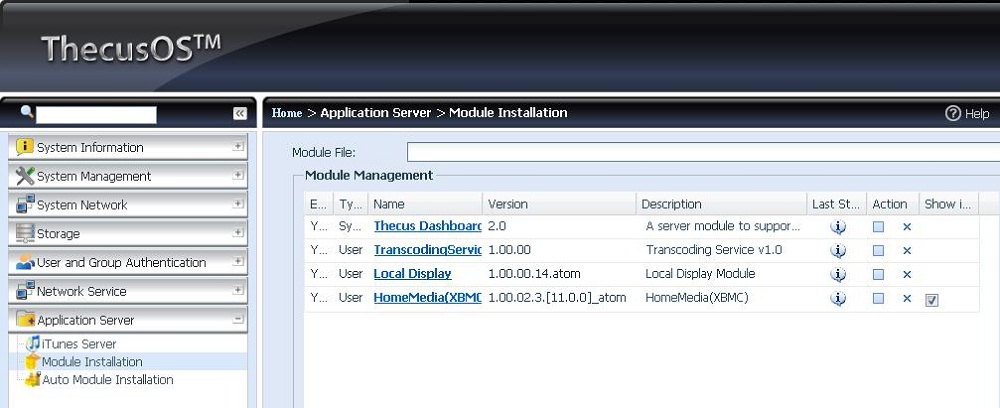
Figure 1: Local Display and XBMC modules installed
Local Display
If you follow the instructions above, the initial display of the Local Display module will show icons for a Firefox browser, terminal session and the XBMC module as shown in Figure 2 below. The Firefox browser is a fully-functioning, Linux-based, Flash-enabled browser that allows you to browse the internet directly on your TV, as you would on your computer. Clicking on the terminal session icon opens a root-access SSH console window.
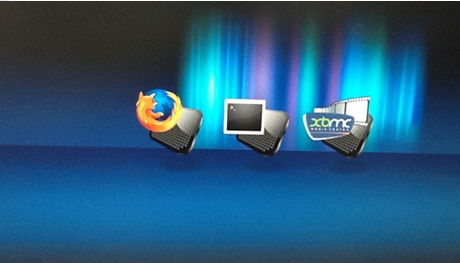
Figure 2: Local Display module home page
Being curious about a baseline performance of the browser in the Local Display module, I decided to run the SunSpider 0.91 JavaScript Benchmark against it. Since the N5550 uses a 1.86 GHz Intel Atom D2550 processor, my closest comparison was the low power 1.80 GHz D525 Atom server I built as a project for SmallNetBuilder. Using Firefox on that low-power server, SunSpider completed in 829.7ms. On the Thecus N5550, SunSpider completed in 932.8ms. (Smaller numbers are better.) My simple test indicated the Thecus N5550 and home-brew server browsers’ performance is about equal, with the Thecus a tad slower.We often use our HTPC to watch YouTube and other videos, so I decided to test this with some common browsing options. Windowed YouTube worked very well. Fullscreen YouTube was acceptable for internet video, although there was occasional choppiness.
I then moved up to testing some HD content on Vudu and Vimeo. With HD Vimeo content, the browser seemed to struggle a bit. Framedrop seemed to happen often, making the video choppy. It was still watchable, but definitely not smooth.
When I tried Vudu I was presented with a message, “Video playback is not supported on this device. Playback is only supported on PCs / Macs and on VUDU-enabled devices". So no Vudu for me!
I cancelled my Netflix streaming account when Netflix split its DVD and streaming service, so I ran another test over at http://www.hd-trailers.net. HD-Trailers.net is a good place to test as it has several resolution options (1080p, 720p and 480p). With the first test at 1080p, video playback was consistent with my test on Vimeo, i.e. very slow and very choppy. 720p was a little better, but definitely still choppy. 480p was the best playback and experienced only occasional video tearing. Disappointing, to say the least.
I ran all of these same tests against our quad-core i7 HTPC to ensure the problems were not bandwidth related. The i7, as you would expect, handled the content much better, although even it had occasional problems playing fullscreen 1080p content perfectly smoothly.
So the Local Display module, in and of itself, is a great start. But if you have a more powerful HTPC, you won’t be turning it in for a Thecus NAS just yet.
XBMC and more
But what about third-party modules? Since Thecus features the XBMC module in its marketing, I decided to take a look at that next. The XBMC interface uses the Confluence skin, which is very polished and beautiful (Figure 3). Within the main screen, the sub options are Weather, LiveTV, Pictures, Videos, Music, Programs and System.
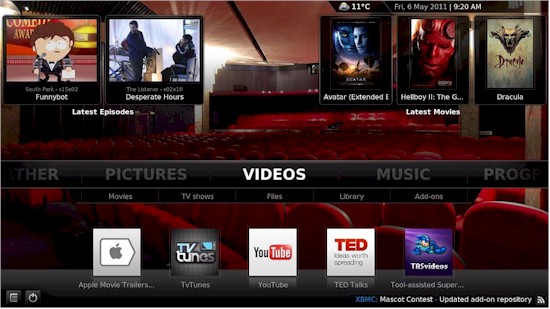
Figure 3: XBMC Confluence skin
I first went into Weather, wanting to get the temperature on the main screen to show my local temp. I went into Settings and tried to run the Location Selector, but received a script error on Location_Selector.py. A quick scan of the forum revealed this was more than likely a problem with Python versioning and one forum member even provided a fix. The developer cautioned that, while the fix may solve the weather problem, it may break some other core functionality. Since I needed the core functionality, I didn’t run the Python fix.
The Python version problem also seems to affect many of the available apps, which can be run under the Programs sub-menu. XBMC has many different apps available for all sorts of features. I had downloaded a Forum Viewer and a Web Viewer and was met with Python errors for both of those as well.
The Live TV sub-menu allows you to watch live TV channels with the use of an optional USB DVB-T tuner. DVB-T is a European standard, so it’s of no use here in the U.S. (A list of supported DVB-T tuners is provided in the last pages of the user’s guide.)
The basic Pictures sub-menu worked as expected and allowed me to browse through pictures, look at EXIF data and set up slideshows. I also attempted to install a few XBMC Add-Ons (such as the Picasa Add-On), but was met with more Python errors.
The Music sub-menu provided the same result as the Pictures menu. I was able to play my own music with the nice interface. However, once I tried to use any Add-Ons, I was presented with Python errors.
Before we get into video performance, which is what most people will probably be using an HTPC for, let’s talk about the XBMC remote. XBMC has a remote for Android and iOS that allows you to control the XBMC from your smart device just as you would use any remote control.
It works through your network’s Wi-Fi connection vs RF, however it is instantaneous. I used the XBMC remote with my Samsung Galaxy SIII and found it worked well, except when you watched a movie. The second you hit Play on a movie, you lose the remote. Figure 4 shows the XBMC remote.
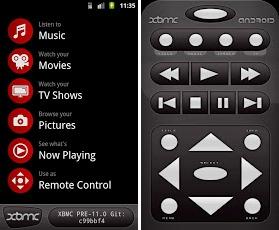
Figure 4: XBMC remote
Most of my testing was done either via the remote or with a Logitech K400 wireless keyboard/mouse combo. When I lost the remote in the movie, the keyboard arrow keys did still work for fast forward, reverse, etc. I found a combination of the two worked best. But I would have preferred that the remote continued to work during video playback.
I tested video performance with a variety of files. First, I watched some SD movies that played fine. Next, I played a 21 GB 1920 x 1080 Blu-ray rip. The first HD movie I watched worked ok. On camera changes there was occasional slight hesitation and video tearing, which could get pretty annoying after some time. I also watched the Thecus performance monitor and saw CPU hanging around 12% and memory climbing to about 70% before coming back down after garbage collection.
I then watched a 26 GB 1920 x 1080 Blu-ray rip. While watching the performance monitor on this one, CPU sat at about 12% while memory would climb to about 95% before dropping back down to 70% and climbing again. Partway through the movie, it simply crashed and I had to exit and re-enter XBMC to get it to play a movie again. I attempted this one several times to try and see a pattern, thinking maybe it ran out of memory, but there seemed to be no correlation between memory status and crashing.
Granted these HD files were very large bit-by-bit rips of blu-ray movies. But in a situation like this, I wouldn’t give up my HTPC for the playback quality of the XBMC module. System utilization implies there is room for improvement and optimization that could smooth things out to an acceptable level. But the XBMC module is third-party and Thecus really isn’t on the hook to support or develop it.
XBMC isn’t the only third-party module out there. Visiting the forum, there are quite a few. I decided to download the VLC module to see if that provided smoother playback.
I loaded up the 26 GB Blu-ray rip of Super Troopers and played it via VLC player while watching the System Performance Monitor. Playback was much better quality in VLC vs. XBMC, although I did experience video tearing at times. While the CPU sat around 12% in XBMC, it was consistently around 95% while running VLC. Video quality was much better, but the occasional tearing might get annoying while watching HD videos.
Aesthetics
The Thecus N5550 looks exactly how I would like a NAS to look, it’s beautiful. I like the information LCD screen on the front, I like the buttons, I like the drive trays. However, for an HTPC those same features make the Thecus not so inconspicuous in a home theater setting. Figure 5 shows the Thecus N5550 on top of our subwoofer and next to the smaller TiVo repurposed HTPC.
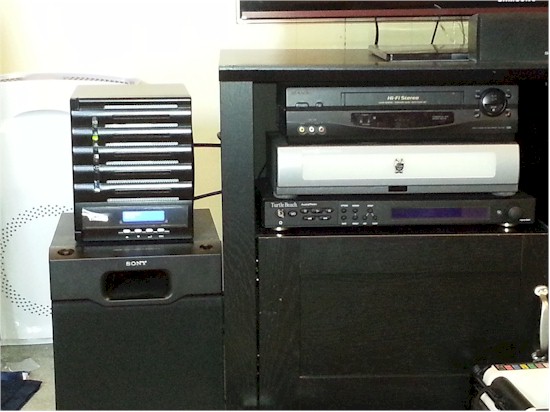
Figure 5: Thecus N5550 size comparison to our subwoofer and TiVo HTPC
The LCD screen cannot be shut off. So in a dark theater setting, it does get a little distracting. On a positive note, noise from the Thecus is next to nothing, with only occasional audible drive noise.
One thing I did find, and this is no fault of Thecus, was that our one year old was drawn to the Thecus like a moth to a flame. She loved pushing the buttons, opening the drive access doors, shutting it off and sometimes even removing drives. On more than one occasion I heard the Thecus alarms going off and came down only to see the 1 year old frantically trying to put the drive back in. (Note that I could have physically locked the drives in place to prevent removal.)
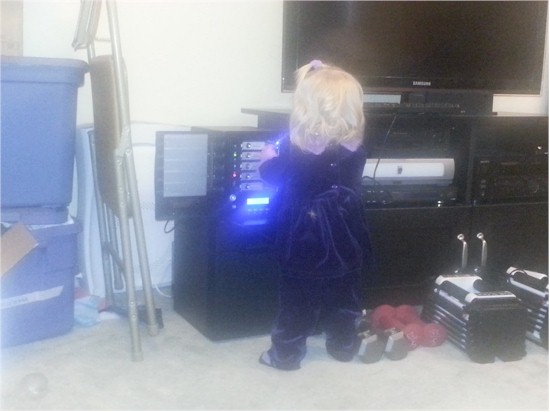
Figure 6: Our 1 year old not being able to resist the flashiness of the Thecus
Closing Thoughts
While I like the concept of endowing NASes with HDMI ports and media playback features, Thecus’ current implementation is not up to the quality level of its other NAS features. Basic connectivity and browser-based playback are for the most part acceptable. But I ran into one platform-based browser block with Vudu and there are probably others.
The main problem with Thecus’ current approach, though, is its dependence on third-party modules. Although it is common for NAS manufacturers to allow and even encourage third-party module development, they usually productize a module once it becomes a key feature.
However, Thecus currently depends on at least one—XBMC—for key features that it promotes as part of its product, yet offers no support or development for it. So if you choose to use one or more of these modules to enhance Thecus’ Local Display feature, be aware you’ll be chasing down and fixing your own problems, with only help from the Thecus forums.
Do I think the Thecus NAS could replace an HTPC? Not right now. While SD playback works well enough, the N5550 struggled with HD content. The reliance on the buggy and unsupported XBMC for local media playback will provide for a very unsatisfying experience for many users and is really not the way to make a positive initial product impression.
I think the NAS-as-HTPC concept has a lot of potential and Thecus has an early lead. If your objective is to simply browse the internet on your TV, checking social media and email and perhaps watching some YouTube, the Local Display module works well enough. But Thecus has more work to do before promoting HD media playback features on its NASes and a lot more to do before you can swap out your HTPC for one of its NASes.

